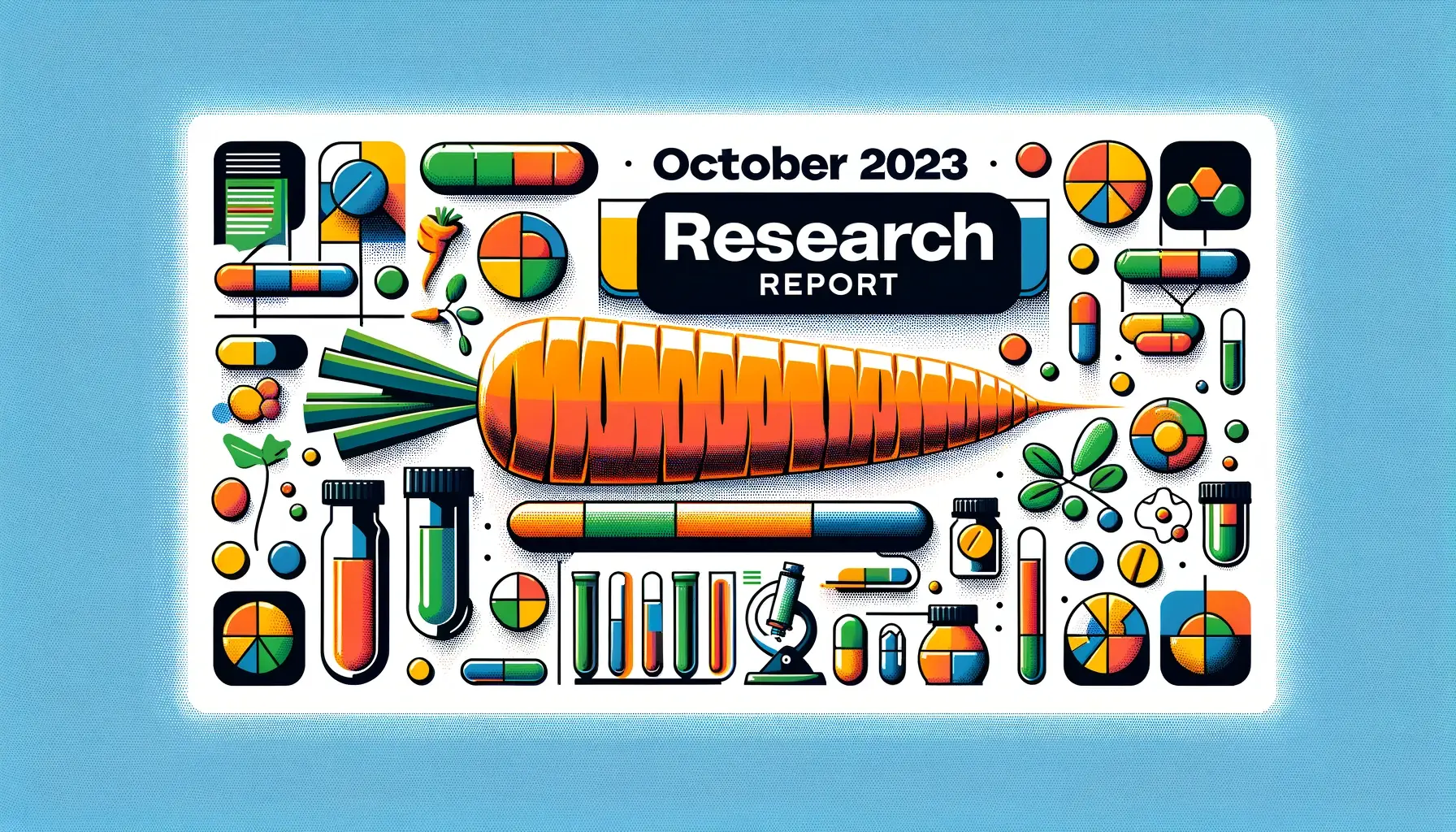Vitamin A Research: Top 5 Discoveries in October 2023

In recent years, Vitamin A has become a focal point of numerous research studies due to its various health benefits. From positively influencing immune responses to protecting vitamins from oxidation, it plays a vital role in our health. In this blog post, we delve into some exciting research on this remarkable nutrient.
1. Combatting Mastitis
A research study has highlighted how a metabolite of Vitamin A can help alleviate Mastitis, a serious disease that affects both humans and animals. This evidently permeates the dairy industry, offering opportunities for mastitis treatment and prevention.
Vitamin A Helps Alleviate Mastitis in Dairy Cows [1]
Vitamin A in the form of Retinoic Acid (RA) can remarkably mitigate Mastitis, a detrimental disease that plagues both humans and dairy cows. Showing potential for improving both prevention and treatment, this research provides a compelling argument for Vitamin A's critical role in overall health. The study focused on Subacute Ruminal Acidosis (SARA), a contributor to Mastitis in cows. It found that cows with SARA had higher levels of RA, a key product of Vitamin A metabolism.
In diving deeper, this research studied the protective effect of RA on Low-Grade Endotoxemia (LGE) induced mastitis and the mechanisms behind this in mice. It is fascinating to note, the data revealed that RA significantly reduced the mammary pro-inflammatory cytokines - biological molecules that drive inflammation. Consequently, RA improved the Blood-Milk barrier damage caused by LGE.
Adding to its credibility, the examination also presented that RA amplifies the expression of proteins vital for cell-cell adhesion in tissues (tight junction proteins like ZO-1, occludin and claudin-3). An even more profound finding was that RA actively restrained inflammation in mammary glands by impeding specific signaling pathways (NF-κB and NLRP3) known for their role in inflammatory responses.
The collective findings from this research underpin the potential role of Vitamin A in curtailing Mastitis and even other similar diseases. This enlightening data can be crucial as we explore new avenues to combat health troubles in both animal and human populations.
2. Stabilization with Wheat Bran
Wheat bran has been proven to stabilize Vitamin A when in oil during storage. This key finding underscores how wheat bran shields Vitamin A and lipids.
Wheat Bran Enhances Vitamin A Stability [2]
A breakthrough research has revealed how wheat bran can enhance the longevity of Vitamin A (also known as retinyl palmitate or RP) in oil during storage, a mystery that had previously remained unresolved. The study explored the implications of the concentration of RP in oil ranging from 0.1–2% and how it affects the retention of RP when stored with native and toasted wheat bran. The results showcased how toasted wheat bran could retain up to 65% of RP even after four weeks, starkly contrasting the much lower RP retention below 10% exhibited by native wheat bran.
Interestingly, this research revealed that lower wheat lipase levels, achieved by a higher oil-to-bran ratio, resulted in better RP retention for native bran, while the toasted bran led to the lowest RP retention at combined high oil and high RP concentrations. This hints toward wheat bran's potential for protecting RP and lipids from oxidation, creating a defensive shield to increase the longevity of these nutrients during storage. However, this defensive shield seems to deteriorate under the influence of the pro-oxidative effect of RP, lipid oxidation, and lipase. Undeniably, this research propels understanding of Vitamin A preservation forward, influencing its longevity in meal components and products.
3. Vitamin and Kidney Disease Patients
Chronic kidney disease (CKD) patients often risk developing vitamin deficiencies, including a lack of Vitamin A. Hence, the importance of vitamin supplementation in the CKD population is evident.
Vitamin Supplementation Key for Chronic Kidney Disease Patients [3]
Patients suffering from chronic kidney disease (CKD), including those receiving dialysis, are vulnerable to vitamin deficiencies due to factors such as poor dietary intake, restricted diets, protein energy wasting, and inadequate sunlight exposure for vitamin D synthesis. Recent research underscores this issue, developing certain symptoms can be subtle, making it hard for them to be detected early. While most vitamins' circulating levels are not routinely tested for in patients (except for folate, B12, and 25-hydroxyvitamin D), it's become increasingly clear that vitamins play an integral role in body function and systems. Specifically, it should be emphasized that routine supplementation of Vitamins A and E may not be necessary due to potential toxicity risks, but other vitamin supplements are crucial.
The research emphasizes personalizing the choice to use water-soluble vitamin supplements based on individual patient factors. This would include their dietary intake, nutritional status, risk of vitamin deficiency/insufficiency, CKD stage, comorbid status, and dialysis loss. For example, those with nutritional vitamin D deficiency should have it corrected, but the supplementation dose and formula must be carefully selected to fit the individual's needs. These individual factors would look at aspects such as the degree of 25-hydroxyvitamin D deficiency, parathyroid hormone levels, CKD stage, and local formulations.
Despite the lack of randomized trials supporting benefits on kidney health with any vitamin supplementation, it's vital for all CKD patients to receive periodic dietary intake assessments. They should aim to obtain various vitamins through natural food sources and maintain a healthy eating pattern that includes vitamin-dense foods. While more research is needed to further illuminate vitamin supplementation's role, there is no denying the importance of a well-rounded diet for overall health, especially for individuals with CKD.
4. Breast Cancer Treatment
Vitamin A derivatives, called retinoids, are being studied for their anti-cancer properties. Their ability to induce cell differentiation and apoptosis plays a significant bearing in combating breast cancer.
Vitamin A Derivatives Showing Promising Anti-Cancer Potential Against Breast Cancer Stem Cells [4]
Breast cancer, accounting for nearly 30% of all diagnosed cancers in females, is a complex disease with a high treatment failure rate. A primary reason behind this is the presence of a unique group of cells within a breast tumor, known as breast cancer stem cells (BCSCs). These cells, marked by certain surface biomarkers like CD44+ and ALDH, display a unique ability for self-renewal and differentiation, thus propelling tumor formation, initiation, and recurrence. Critics suggest that focussing on BCSCs could lead to the development of new therapeutic strategies.
Additionally, an irregular regulation of particular signaling pathways within these cells leads to cancer stem cell formation and subsequent tumor development. An increasingly challenging facet of breast cancer is the growing drug resistance, underscoring the urgent need for fresh therapeutic strategies to combat this severe illness. Hope comes in the form of retinoids, a large group of synthetic derivatives of Vitamin A. Widely studied as chemopreventive agents in clinical trials, retinoids regulate various key biological functions. Moreover, they can induce cell differentiation and apoptosis, significantly influencing the transformation of tissues into malignant forms.
This transformative activity of retinoids has been extensively investigated for their potential in cancer treatment and prevention. The high receptor-binding affinity of retinoids enables them to directly modulate gene expression programs, helping in disease modulation. Therefore, retinoids, primarily Adapalene, a third-generation retinoid, exhibit tantalizing anti-cancer potential. Summarizing current understandings of BCSCs and associated signaling pathways could pave the way for retinoids to function as therapeutic agents to specifically target BCSCs, leading to a much-needed breakthrough in the fight against breast cancer.
5. Beta-carotene Utilization
Research has shown that the addition of six specific polysaccharides drastically improves beta-carotene utilization by modulating gut microbiota. As beta-carotene is a precursor to Vitamin A, this finding has crucial implications for absorption and nutrition.
Polysaccharides Enhance Beta-Carotene Utilization and Vitamin A Absorption [5]
A study investigating the effects of six specific polysaccharides (arabinoxylan, arabinogalactan, mannan, inulin, chitosan, and glucan) emphasizes their notable role in enhancing beta-carotene utilization in our body, contributing to improved Vitamin A absorption and nutrition. This impressive influence on beta-carotene, the precursor to Vitamin A, was observed with both in vitro and in vivo approaches. The study indicated that the addition of these polysaccharides resulted in decreased beta-carotene retention and a significant boost in retinol content - implying improved utilization of beta-carotene and its conversion to Vitamin A.
When mice were treated with these six polysaccharides, their serum beta-carotene content significantly shot up against the group treated with beta-carotene alone. Further, retinoid (Vitamin A and its derivatives) accumulation in the serum, liver, and small intestine significantly augmented, underlining the far-reaching effects of these polysaccharides. Additionally, gut microbial changes were noted, suggesting that they too play a critical part in enhancing Vitamin A nutrition.
Interestingly, the addition of these polysaccharides led to increased production of Short Chain Fatty Acids (SCFAs), significantly altering the structure and composition of gut microbiota. Not only this, but a strong association was also found between certain families of gut microbes (Ruminococcaceae and Odoribacteraceae) and beta-carotene metabolism and absorption. These findings make it clear that the addition of these polysaccharides could be a game-changer in improving beta-carotene utilization and, in essence, Vitamin A absorption. Such advancements propose promising strategies for dealing with Vitamin A deficiency, thereby improving our overall health and wellness.
Conclusion
These research breakthroughs underline the significance and potential of Vitamin A in various aspects of health. From combatting serious diseases such as mastitis and breast cancer to enhancing the absorption and retention of other nutrients, the potential applications and benefits of Vitamin A are fascinating and extremely impactful for both human and animal health.
References
Wu, K., Shang, S., Bao, L., Zhao, Y., Guan, Z., Xu, J., Sun, H., Yuan, W., Fu, Y., Peng, L., & Zhao, C. (2023). Retinoic acid ameliorates low-grade endotoxemia-induced mastitis by limiting inflammatory responses in mice. Microbial Pathogenesis, 106426. https://doi.org/https://doi.org/10.1016/j.micpath.2023.106426
Van Wayenbergh, E., Langenaeken, N. A., Verheijen, J., Foubert, I., & Courtin, C. M. (2024). Mechanistic understanding of the stabilisation of vitamin A in oil by wheat bran: The interplay between vitamin A degradation, lipid oxidation, and lipase activity. Food Chemistry, 436, 137785. https://doi.org/https://doi.org/10.1016/j.foodchem.2023.137785
Yee-Moon Wang, A., Afsar, R. E., Sussman-Dabach, E. J., White, J. A., MacLaughlin, H., & Ikizler, T. A. (2023). Vitamin Supplement Use in Patients With CKD: Worth the Pill Burden? American Journal of Kidney Diseases. https://doi.org/https://doi.org/10.1053/j.ajkd.2023.09.005
Jan, N., Sofi, S., Qayoom, H., Haq, B. U., Shabir, A., & Mir, M. A. (2023). Targeting breast cancer stem cells through retinoids: A new hope for treatment. Critical Reviews in Oncology/Hematology, 192, 104156. https://doi.org/https://doi.org/10.1016/j.critrevonc.2023.104156
Shi, E., Nie, M., Wang, X., Jing, H., Feng, L., Xu, Y., Zhang, Z., Zhang, G., Li, D., & Dai, Z. (2023). Polysaccharides affect the utilization of β-carotene through gut microbiota investigated by in vitro and in vivo experiments. Food Research International, 174, 113592. https://doi.org/https://doi.org/10.1016/j.foodres.2023.113592
